
The National Register of Historic Places in the United States is a register including buildings, sites, structures, districts, and objects. The Register automatically includes all National Historic Landmarks as well as all historic areas administered by the U.S. National Park Service. Since its introduction in 1966, more than 90,000 separate listings have been added to the register.

Doughoregan Manor is a plantation house and estate located on Manor Lane west of Ellicott City, Maryland, United States. Established in the early 18th century as the seat of Maryland's prominent Carroll family, it was home to Founding Father Charles Carroll, a signer of the United States Declaration of Independence, during the late 18th century. A portion of the estate, including the main house, was designated a National Historic Landmark on November 11, 1971. It remains in the Carroll family and is not open to the public.
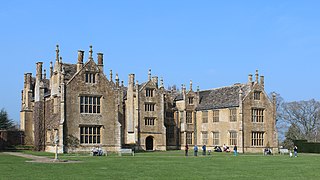
Barrington Court is a Tudor manor house begun around 1538 and completed in the late 1550s, with a vernacular stable court (1675), situated in Barrington, near Ilminster, Somerset, England.

The Thomas Stone National Historic Site, also known as Haberdeventure or the Thomas Stone House, is a United States National Historic Site located about 25 miles (40 km) south of Washington D.C. in Charles County, Maryland. The site was established to protect the home and property of Founding Father Thomas Stone, one of the 56 signers of the United States Declaration of Independence. His home and estate were owned by the Stone family until 1936.
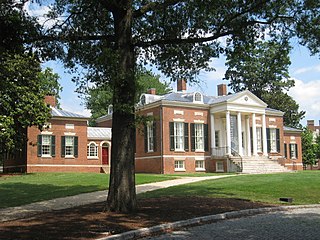
The Homewood Museum is a historical museum located on the Johns Hopkins University campus in Baltimore, Maryland. It was listed as a National Historic Landmark in 1971, noted as a family home of Maryland's Carroll family. It, along with Evergreen Museum & Library, make up the Johns Hopkins University Museums.

Darnall's Chance, also known as Buck House, Buck-Wardrop House, or James Wardrop House, is a historic home located at 14800 Governor Oden Bowie Drive, in Upper Marlboro, Prince George's County, Maryland, United States.

The Joseph Webb House is a historic Georgian-style house at 211 Main Street in Wethersfield, Connecticut. It was designated a National Historic Landmark for its significance as the location of the five-day military conference between George Washington and French commander Rochambeau in 1781 during the American Revolutionary War that preceded the Siege of Yorktown, the last major battle of the war. Washington lodged at the house of Joseph Webb on May 17, 1781 in Old Wethersfield. The Joseph Webb House is owned by the Webb-Deane-Stevens Museum and serves as its headquarters. The interior has been restored to an 18th-century appearance and the grounds feature a Colonial Revival garden and 19th-century barn in back.

The William Paca House is an 18th-century Georgian mansion in Annapolis, Maryland, United States. Founding Father William Paca was a signatory of the Declaration of Independence and a three-term Governor of Maryland. The house was built between 1763 and 1765 and its architecture was largely designed by Paca himself. The 2-acre (8,100 m2) walled garden, which includes a two-story summer house, has been restored to its original state.

The Kennedy Farm is a National Historic Landmark property on Chestnut Grove Road in rural southern Washington County, Maryland. It is notable as the place where the radical abolitionist John Brown planned and began his raid on Harpers Ferry, Virginia, in 1859. Also known as the John Brown Raid Headquarters and Kennedy Farmhouse, the log, stone, and brick building has been restored to its appearance at the time of the raid. The farm is now owned by a preservation nonprofit.
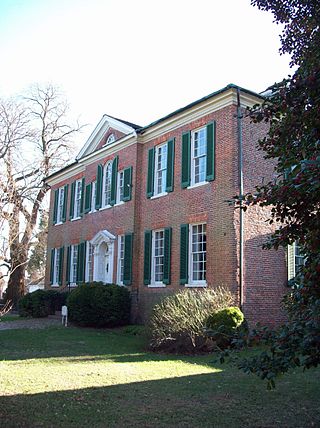
His Lordship's Kindness, also known as Poplar Hill, is a historic plantation estate on Woodyard Road east of Clinton, Maryland. It was built in the 1780s for Prince George's County planter Robert Darnall. The five-part Georgian mansion retains a number of subsidiary buildings including a slave's hospital and a dovecote. The property is now operated as a museum by a local nonprofit preservation group. It was designated a National Historic Landmark in 1970.

Mount Clare, also known as Mount Clare Mansion and generally known today as the Mount Clare Museum House, is the oldest Colonial-era structure in the City of Baltimore, Maryland, U.S.A. The Georgian style of architecture plantation house exhibits a somewhat altered five-part plan. It was built on a Carroll family plantation beginning in 1763 by barrister Charles Carroll the Barrister, (1723–1783), a descendant of the last Gaelic Lords of Éile in Ireland and a distant relative of the much better-known Charles Carroll of Carrollton, (1737–1832), longest living signer of the Declaration of Independence and the richest man in America in his later years, also the layer of the First Stone of the new Baltimore and Ohio Railroad, just a short distance away in 1828.

West St. Mary's Manor is a historic house on West St. Mary's Manor Road in rural St. Mary's County, Maryland. Built in the 1780s according to dendrochronology and with a four-room center-hall plan, and is located on the first recorded English land grant in what is now Maryland. It was designated a National Historic Landmark in 1970.

Riversdale, is a five-part, large-scale late Georgian mansion with superior Federal interior, built between 1801 and 1807. Also known as Baltimore House, Calvert Mansion or Riversdale Mansion, it is located at 4811 Riverdale Road in Riverdale Park, Maryland, and is open to the public as a museum.

The Shrine of St. Anthony is a Roman Catholic shrine honoring St. Anthony of Padua. The shrine is located within the St. Joseph Cupertino Friary in Ellicott City, Maryland, USA. The shrine is a ministry of the Conventual Franciscan Friars, Our Lady of the Angels Province, USA.

Mount Lubentia is a historic house located at Largo in Prince George's County, Maryland, United States. It is an elegantly detailed 2+1⁄2-story Georgian/Federal-style, Flemish bond brick house, probably built about 1760 and substantially renovated in the late 1790s, by Enoch Magruder and his son, Dennis of Harmony Hall.

Oxon Hill Manor is a neo-Georgian house of 49 rooms, located at Forest Heights, Prince George's County, Maryland. It was designed in 1928 for Sumner Welles (1892-1961) by the Washington architect, Jules Henri de Sibour (1872-1938). It was built in 1929, and consists of a two-story main block of Flemish bond brick and a northern wing. Also on the property are two outbuildings contemporary with the house; a five-car garage and attached manager's quarters and greenhouse, and a stable. There are also formal gardens on the grounds.

Burleigh, or Burleigh Manor, or Hammonds Inheritance is a historic home located at Ellicott City, Howard County, Maryland, built on a 2,300-acre (930 ha) estate. Which included "Hammonds Inheritance" patented in 1796. It is a Federal-style brick dwelling built between 1797 and 1810, laid in Flemish bond. Based on the 1798 Tax assessment of the Elkridge Hundred, the original manor house started as a one-story frame building 24 by 18 foot in size. Also on the landscaped grounds are a 1720 stone smokehouse; a much-altered log, stone, and frame "gatehouse" or "cottage," built in 1820 as a workhouse for slaves and another log outbuilding, as well as an early-20th century bathhouse, 1941 swimming pool, and tennis court. Portions of the estate once included the old Annapolis Road which served the property until the construction of Centennial Lane to connect Clarksville to Ellicott City in 1876. The manor was built by Colonel Rezin Hammond (1745–1809), using the same craftsmen as his brother Mathias Hammond's Hammond–Harwood House in Annapolis. Rezin and his brother Matthias were active in the colonial revolution with notable participation in the burning of the Peggy Stewart (ship). Hammond bequeathed the manor and 4,500 acres (1,800 ha) to his grandnephew Denton Hammond (1785–1813) and his wife Sara who lived there until her death in 1832. All slave labor were offered manumission upon Rezin Hammonds death in 1809, with extra provisions for tools, land and livestock for thirty two slaves. The estate was owned by Civil War veteran Colonel Mathias until his death where he was buried alongside other family members on the estate. His wife Clara Stockdale Hammond maintained ownership afterward. In 1914 the estate was owned by Mary Hanson Hammond with land totaling over 1,000 acres (400 ha) including the outbuildings and slave quarters. In 1935 the Estate was subdivided to 600 acres (240 ha) and purchased by Charles McAlpin Pyle, Grandson of industrialist David Hunter McAlpin. The manor house was renovated with the great kitchen replaced by a "Stirrup Room" where meetings of the Howard County Hunt Club were performed. The house was sold in 1941 to Mrs. Anthony J. Drexel Biddle, Jr. for use of Prince Alexandre Hohenlohoe of Poland during WWII. St. Timothy's School bought the property after the war in 1946, but abandoned plans and sold to Mrs G. Dudley Iverson IV in 1950. The brick was once painted yellow, but by 1956, had almost returned to exposed red brick. As of 2013, it has operated as a livestock shelter.
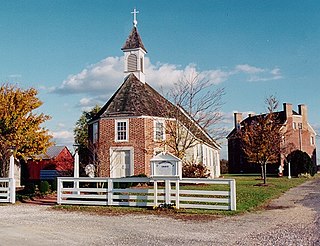
St. Francis Xavier Church and Newtown Manor House Historic District is the first county-designated historic district in Saint Mary's County, the "Mother County" of Maryland and is located in Compton, Maryland, near the county seat of Leonardtown. The district marks a location and site important in the 17th-century ecclesiastical history of Maryland, as an example of a self-contained Jesuit community made self-supporting by the surrounding 700-acre (2.8 km2) farm. The two principal historic structures were added to the National Register of Historic Places in 1972. Archaeological remains associated with the site date back to the early colonial period, mid-17th century.

Rose Hill Manor, now known as Rose Hill Manor Park & Children's Museum, is a historic home located at Frederick, Frederick County, Maryland. It is a 2+1⁄2-story brick house. A notable feature is the large two-story pedimented portico supported by fluted Doric columns on the first floor and Ionic columns on the balustraded second floor. It was the retirement home of Thomas Johnson (1732–1819), the first elected governor of the State of Maryland and Associate Justice of the United States Supreme Court. It was built in the mid-1790s by his daughter and son-in-law.
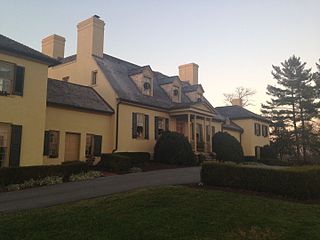
The Belmont Estate, now Belmont Manor and Historic Park, is a former plantation located at Elkridge, Howard County, Maryland, United States. Founded in the 1730s and known in the Colonial period as "Moore's Morning Choice", it was one of the earliest forced-labor farms in Howard County, Maryland. Its 1738 plantation house is one of the finest examples of Colonial Georgian architectural style in Maryland.
























